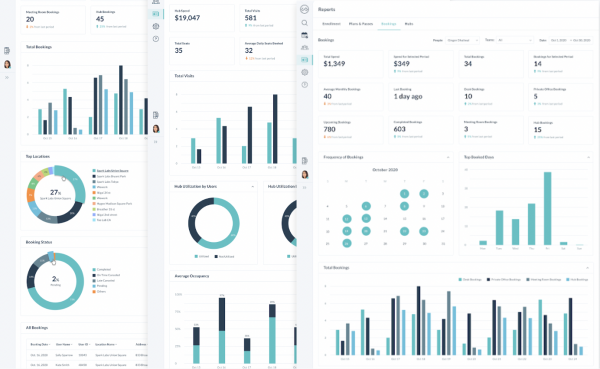People today demand flexibility from their employers. Studies show more than three quarters of employees consider more flexibility in work location and hours to be a key factor when evaluating new job opportunities. But flexibility can be complicated! Here is Upflex’s comprehensive how-to for implementing hybrid work.
What is a hybrid workplace?
A hybrid workplace arrangement combines in-office working and remote working modes. An effective hybrid workplace approach needs clear communication and the appropriate technology. This increasingly popular way of working separates the idea of productivity from the mandate of a single, five-days-a-week office space. Using a combination of smart space usage planning, modern management approaches and a hybrid real estate strategy of owned or leased space, flexible space, and even employees’ home offices, it enables team members to perform effectively and efficiently, no matter where they’re working from.
In the hybrid workplace, energy is focused on productivity, not attendance. Employees are given some freedom of choice over whether to work remotely or in the office, as long as they maintain professionalism, consistently complete duties and meet set goals. When done effectively, hybrid work can reduce the time suck — and the carbon footprint — associated with commuting to work, and boost everything from productivity to employee engagement, acquisition and retention.
But, change is hard. And transitioning from the traditional workplace to a hybrid workplace requires some mindset shifts. Here are a few pointers on overcoming some of the challenges in the shift to hybrid.
Creating a hybrid work strategy
Understand employees’ work preferences
The idea of a blended workplace is not new. Before the pandemic, major international companies, including Yahoo!, IBM, Reddit, Bank of America, Aetna, and AT&T, tried and mostly abandoned the endeavor to introduce hybrid working arrangements and programs. Poor communication and coordination among employees were the main causes that lowered employee motivation and performance.
“One thing we really focus on is data, not just because it’s essential to making smarter, more informed real estate decisions,” said Upflex CPO and cofounder Ginger Dhaliwal in a recent keynote on hybrid work; “data is also central to the question of a happier workforce.” Imagine spending a lot of money on a costly office renovation or providing various employee benefits, only to discover that most employees still prefer to work remotely from their homes, favorite coffee shops, or coworking spaces.
Before you institute a new workplace policy, first, work to understand the preferences of employees through an employee survey, look at the data, and work with a workspace strategy expert to create a plan — between your organization’s leased or owned spaces, coworking space, and home offices — that works for your teams.
Define the office’s primary function
Want employees to come “back to the office”? Leadership will need to answer one key question: “What’s the point?” Most workers engage in both group and solitary work throughout the course of a normal day — from research projects and heads-down thinking and writing, to client meetings, conference calls and team brainstorms. A functional hybrid workplace has space for all of it, without paying big for extravagant meeting rooms, private phone booths, and cozy corner offices. Successful enterprises transitioning to hybrid are finding that, with the right data on what their teams actually need, their existing leased or owned office space can be reconfigured to support those needs in just the right amounts, and they can draw on an aggregated flex space network to supplement the rest — ultimately offering more variety, choice, and customization to employees while cutting their real estate costs.

A successful hybrid workplace calls for new ways of thinking about work — and new skillsets. Think about creating new positions on your team to supervise the development and application of hybrid work when it comes to logistics, real estate, employee safety and wellbeing, and data privacy and security.
Get full buy-in across the C-suite
A hybrid work approach affects both the entire workforce and business outcomes. Certain leaders must be involved in the process from the start. The CEO, the CISO, who also serves as CIO, the top legal counsel, and the IT department, which handles the practical aspects of technology, are all decision-makers.
Implement your hybrid workplace plan
Modify — and modernize — your real estate portfolio.
Ensure your office strategy is agile enough to allow for responsive changes to new circumstances and new needs when it comes to office dimensions and space configurations in response. Utilization data, like the data Upflex provides to managers in terms of workspace usage in leased, owned, and third-party flexible workspaces, can help leaders to understand how employees are using workspace, spot trends, and patterns, and make improvements to create workspaces that best serve their requirements.
Use technology to make hybrid work more time- and cost-efficient.
Sure, there’s a world of new remote work tech, from next-generation conference room AV tech, to VR that helps give people “a seat at the table” even when they’re halfway around the globe. While polls show executives intend to boost funding for online collaboration tools in 2023, there’s another gap to fill first: Better and more efficient management of the invoices, agreements, and data collection when it comes to workspace.
- PRO TIP: Upflex, a single-vendor solution with a network of more than 10,000 workspaces in 120+ countries, allows enterprises to manage all their workspace in one smart platform, with one agreement and one monthly invoice to cover hundreds of workspace operator brands. Click here to learn more.
Consider new, hybrid-focused roles
Think about creating new positions on your team to supervise the development and application of hybrid work when it comes to logistics, real estate, employee safety and wellbeing, and data privacy and security. A compliance officer might be appointed by leaders to uphold health, safety, data privacy and security standards.
Adapt your management approach to suit hybrid work
Support mental health and stress reduction
Employees are still under stress from the pandemic, and HR directors are under pressure to come up with practical ways to manage employees’ mental health in a hybrid workplace. Some of this comes down to designing and implementing a strong employee wellness program. It’s also a matter of hiring and upskilling leaders with the right management skills for remote and hybrid teams.
Keep employees on equal footing, no matter where they’re working from.
“Many companies today will have a portion of their workforce that’s going to be fully remote. One of the challenges we see companies facing is: How do you create an equitable relationship across all the different work locations?,” said Upflex CPO and cofounder Ginger Dhaliwal in a recent talk on how to boost employee retention in the hybrid or remote workplace.
Equal treatment of on-site and remote workers is essential. Make sure people who spend more time in the office are not given preference over those who work on-site. To determine whether all employees believe they are receiving fair treatment and being included in new opportunities, use internal polls to gather data.

The key to a happy workplace is data. Platforms like Upflex provide insights into workspace needs and preferences for employees, so real estate teams can make smarter decisions toward more sustainable strategies.
Create opportunities for employees to connect
Part of this equal footing is about making sure everyone has a chance to meet and work face to face, at some point. Remote-first companies need to get everyone in the same place periodically, and that requires planning — and investment.
Employees who work in the same city can use a service like Upflex to come together in a “third place” workspace, even if they’re not working from the main office.
“Culturally, a lot of companies like ours that are remote-first are making effort to get their teams together. But, one team in our organization could include people from all over the world,” Dhaliwal says. “Our customer service team, for example, is based across New York, Toronto, Lisbon, London, and Vietnam. We’re not spending money on offices, but we do need to have a budget to allow these teams to come together in person on occasion.”
Upflex also hosts yearly retreats for everyone in the organization to meet at a convenient spot. “Again, we have talent all over the globe, so we need to cognizant as we choose those meeting locations that every VISA is viable and there are no limitations,” she adds. Consider building all-team meetings into your plan — and budget — as you transition to hybrid work.
- PRO TIP: Workspace management solutions like Upflex build tech and solutions that help boost collaboration even for hybrid teams. Meet with an Upflex workspace advisor to learn more.
4. Implement and iterate for the best results
Since most firms are new to the hybrid working arrangement, a hybrid workforce strategy, achieving so will require persisting strategy improvement. Get employee weigh-in to understand what’s working — and what’s not. Try a maturity model to work out the kinks:
- Phase one: Explain the rules for on-site and remote work, including when workers can work from home (for example, two days per week).
- Phase two: When using this approach, evaluate if the organization is fulfilling its goals.
- Phase three: Take into account what is functioning well with this model, modify accordingly and enhance hybrid workforce policies.
Ready to make the leap?
Upflex develops cutting-edge technology to assist businesses in cutting real estate costs while boosting business. Meet with an Upflex workspace solutions advisor to talk about how Upflex’s technology, solutions and flexible space network can help ease your organization’s shift to hybrid while reducing your office spend.


